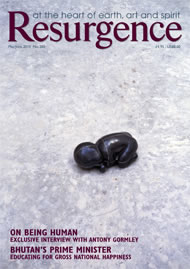I first met Rupert Sheldrake at the Mystics and Scientists Easter conference in 1983, where he shared a platform with David Bohm, with whom he had a number of dialogues at the time. A New Science of Life had been out for a couple of years and had already created a huge stir, notably when John Maddox famously stated that the book was infuriating, and the best candidate for burning for many years. Burning, of course, is associated with heresy, and Rupert is a paradigmatic scientific heretic so far as orthodoxy is concerned. It’s a great pity that this categorisation of orthodoxy and heresy, inherited from Christianity, has been perpetuated in science, which should be an empirical pursuit. Rupert spoke eloquently and without notes at the conference, about his theory and its implications. It is hard to believe that more than twenty-five years have elapsed – an entire generation – and it is regrettable that in some quarters the prejudice against his approach is as strong as ever. However, informed members of the general public beg to differ.
Last summer, some readers may have noticed that this author wagered a case of fine port (with fellow biologist Lewis Wolpert) that molecular biology will not fulfil its promise of predicting in at least one case, given the genome of a fertilised egg of an animal or plant, all the details of the organism that develops from it, including any abnormalities. The same Lewis Wolpert, who is quoted on the original book as saying that “Sheldrake’s ideas are just nonsense” has now debated with him a number of times in public but still reflects the widespread view that such things are impossible and therefore untrue. The preface of the 2009 edition of the book reviews developments of the last twenty-five years, while restating the original hypothesis of formative causation, which claims that Nature is habitual, as opposed to being governed by eternal laws.
An important theme is the way in which mechanistic biology has revealed its own limitations as a complete explanation of life and mind. It has turned out, for example, that humans have far fewer genes than expected and that the diversity of body plans is not reflected in diversity at the level of genes. This leaves a theoretical gap, which Rupert explains in terms of morphogenetic and morphic fields. He has expanded the scope of his original work, extending his studies as a biologist to telepathy in animals, which he regards as a natural capacity. He has also democratised the research process by enabling people to take part in experiments online.
The book retains its original structure, but much of the text has been revised and updated. Rupert has been giving lectures to younger scientists in universities, and has found that they do not exhibit the same resistance to his ideas as their teachers. They are not so wedded to inflexible laws, and are open to the theory of morphic resonance, which claims that previous forms have a causal influence on present forms across space and time. The plausibility of this theory is discussed in detail in relation to the rest of science, and Rupert proves to be extraordinarily well-informed across a number of disciplines.
As in the first edition, the final chapter outlines four different metaphysical theories, all of which are compatible with the hypothesis of formative causation. However, there is a close correlation between the mechanistic theory of life and the metaphysical theory of materialism, which, as Rupert points out, are frequently confused. He suggests that a modified materialism is one possibility, as is a modified dualism whereby the conscious self interacts with the body through morphic fields. The third picture depicts a creative universe along the lines of Bergson, while the fourth briefly explains transcendent reality.
I thought, in the light of the many developments of consciousness studies in the last fifteen years, that this discussion could have been extended and that Rupert could have formulated his own view more fully, rather than leaving the reader suspended between four metaphysical positions – I think this was tactically astute in the first edition, but arguably no longer necessary. The appendices contain new tests for morphic resonance and an interesting dialogue with David Bohm. This is a welcome update for a new generation of readers, and it arrived just in time: the glue on my original paperback is now disintegrating.








